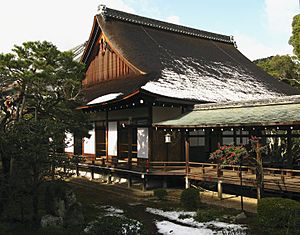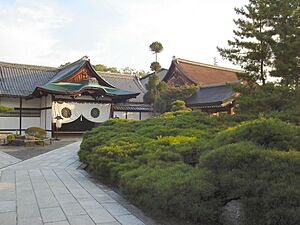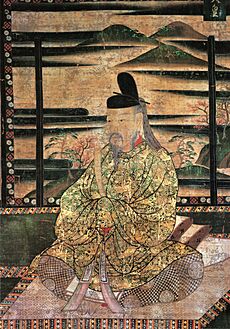Daikaku-ji facts for kids

Daikaku-ji (大覚寺, Daikaku-ji) is a famous Buddhist temple in Kyoto, Japan. It is located in the western part of the city. This special place was once a home for Emperor Saga (785–842 CE). Later, several emperors used it as a place to live after they retired.
The temple is also home to the Saga Go-ryū school of ikebana. Ikebana is the Japanese art of flower arranging. Daikaku-ji has a beautiful artificial lake called Ōsawa Pond. This pond is one of the oldest Japanese garden ponds still around from the Heian period (794-1185 CE).
History of Daikaku-ji Temple
The story of Daikaku-ji began in the year 814 CE. This was during Japan's Heian period. Emperor Saga built a palace here called the Saga-in. It later became his home after he retired. It was known as the Saga Rikyu imperial villa.
A story says that Japan faced a terrible sickness. A Buddhist monk named Kobo Daishi suggested something special. He asked Emperor Saga to copy a very important Buddhist text. This text was called the Heart Sutra (Hannya Shingyō). The emperor copied it by hand. People believe the sickness then ended.
This handwritten sutra is kept at the Shingyōden hall in the temple. It is shown to the public only once every sixty years. The next time will be in 2078. Even today, people visit the temple to make their own copies of the sutra. These copies are then kept at the temple with the original.
In 876, Emperor Saga's daughter, Princess Masako (810–879), changed the palace into a temple. She named it Daikaku-ji. This temple was a monzeki temple. This meant that only princes from the imperial family could become its head priest.
Over time, several emperors retired and lived here. In the 13th and 14th centuries, emperors like Emperor Go-Saga and Emperor Go-Uda lived at Daikaku-ji. They became monks but still made important decisions from the temple. This was known as cloistered rule.
In 1336, the temple was unfortunately burned down. But it was rebuilt later. During the Edo period (1603-1868), Emperor Go-Mizunoo moved some buildings here. These buildings came from the Kyoto Imperial Palace. The main hall, called the hondō, and the Founder's Hall were also moved from the Imperial Palace. The main statues inside are of powerful Buddhist figures.
The sliding doors in the Okanmuri-no-ma room have beautiful paintings. Artists Kanō Sanraku and Shikō Watanabe painted them. They show peony trees and plum blossoms. A unique painting of a hawk is also there. These artworks are very important and protected. They are called Important Cultural Properties.
In 1936, a new school of flower arranging started here. It was called the Saga Go-ryū school. It was founded by Tsujii Kōshū. This school was named in honor of Emperor Saga.
Ōsawa Pond and Garden
The Ōsawa Pond is even older than the temple itself. It is a large artificial lake, about 2.4 hectares in size. Emperor Saga created it between 809 and 842. The pond was designed to look like Dongting Lake, a famous lake in China.
This garden was a chisen-shuyu style garden. This means it was made to be enjoyed from a boat. It was similar to imperial Chinese gardens of that time. The lake was made by blocking a stream. This stream came from a waterfall called Nakoso.
At the north end of the pond are two islands. One is large, and the other is small. The small island is known as Chrysanthemum Island. Between the islands are small rocky spots. They look like Chinese boats anchored in the water. On a hillside north of the lake, there is a "dry waterfall." This is a special arrangement of stones. It makes you imagine a real waterfall.
The garden was famous in old Japanese poems. A poem by Ki no Tomonori talks about Chrysanthemum Island. It describes how beautiful the chrysanthemums are there. Another old poem describes the dry waterfall. It says that even though the waterfall is silent, its name is still heard.
Because of the pond and its flowers, the Saga school of ikebana began here. It honors Emperor Saga.
The lake was also a perfect spot to watch the moon rise from boats. Today, it is still a popular place to see cherry trees bloom. Every autumn, a moon-viewing party is held for three days. It features dancers, musicians, and special dragon boats. The lake is now a popular park for people in Kyoto.
Besides the lake garden, there is also a large courtyard garden. It is located between the temple buildings.
See also
- Rokkaku-dō
- Enshō-ji (Nara)
- List of Buddhist temples in Kyoto
- List of National Treasures of Japan (ancient documents)
- List of National Treasures of Japan (writings)
- For an explanation of terms concerning Japanese Buddhism, Japanese Buddhist art, and Japanese Buddhist temple architecture, see the Glossary of Japanese Buddhism.







